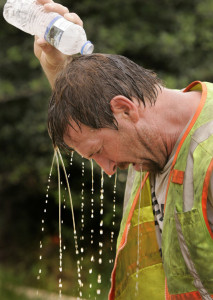The world is getting hotter. And for those who work outdoors, climate change could mean very dangerous working conditions. As the heat index increases, stricter regulations and safety practices need to be implemented to ensure the health of our workers. Not doing so could be the difference between life and death.
People working jobs that require time outside, especially those working strenuous jobs outside must protect themselves from heat illness. The body is vulnerable to heat illness when our natural cooling mechanisms are not enough, allowing out body temperatures to rise to dangerous levels if precautions are not taken such as drinking water and resting in shade or air condition. Heat illness can take many forms, such as heat rash, heat cramps, heat exhaustion and heat stroke which requires immediate medical attention, and can result in death. Extreme heat increases the chances of deaths from cardiovascular and respiratory disease as the raised levels of ozone and other pollutants in the air from climate change exacerbate these diseases along with increased pollen and other aeroallergen levels.
Most employers understand the risk of heat illness and prepare by establishing a heat illness prevention programs that provide workers with water, rest, shade and modified schedules for those who need to acclimatize to the hot conditions such as new workers or those who have not been working for a week or more. The danger increases when workers have to wear bulky protective clothing or take part in intensive work tasks; similarly, working in full sunlight can increase the heat index values by 10 degrees Celsius.
Though both employers and employees should understand these risks, there are still cases where heat illness caused death. Between 2008 and 2014, the Occupational Safety & Health Administration (OSHA) had 109 reports of workers’ deaths due to heat illness with 15 of those recorded in Texas. Though employers do not have to legally comply with the OSHA standards for heat illness prevention, they must have some version of such a program to protect their workers.
With recent increases in the global temperature due to climate change, conditions only become more and more dangerous for workers. In the last 100 years, the world has warmed by .75 degrees Celsius with the last 3 decades successively warmer since 1850. These increased temperatures are expected to cause about 250,000 additional deaths per year from malnutrition, malaria and heat stress between 2030-2050. With increased average temperatures, more frequent and more intense heat waves are expected to occur. Throughout the U.S. the number of days with high temperatures above 90F is predicted to increase, especially in the Southeast and Southwest.
If the frequency of heat waves and extreme heat days follows this prediction, then all workers will be at risk for heat illness and even greater measures must be taken in order to protect their health. But more importantly, measures must be taken to prevent the increase of climate change in the first place—this problem that has the power to negatively affect every single aspect of our lives.



